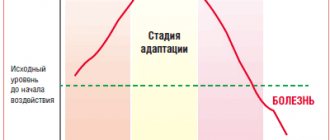K. Izard. The impact of emotions on a person Added by Psychology OnLine.Net 09/12/2004 (Edit 04/28/2006) Emotions affect the body and mind of a person, they influence almost all aspects of his existence. In subsequent chapters, we will look in detail at how specific emotions affect various aspects of human biological, physiological, and social functioning. Here we will only outline in very general terms the enormous influence that emotions have on our lives.
Emotions and body
In a person experiencing an emotion, a change in the electrical activity of the facial muscles can be recorded (Rusalova, Izard, Simonov, 1975; Schwartz, Fair, Greenberg, Freedman, Klerman, 1974). Some changes are also observed in the electrical activity of the brain, in the functioning of the circulatory and respiratory systems (Simonov, 1975). The pulse of an angry or frightened person can be 40-60 beats per minute higher than normal (Rusalova et al., 1975). Such sharp changes in somatic indicators when a person experiences a strong emotion indicate that almost all neuro-physiological and somatic systems of the body are involved in this process. These changes inevitably affect the individual's perception, thinking and behavior, and in extreme cases can lead to physical and mental disorders. Emotion activates the autonomic nervous system, which in turn affects the endocrine and neurohumoral systems. The mind and body require action. If behavior adequate to emotions for one reason or another is impossible for an individual, he is at risk of psychosomatic disorders (Dunbar, 1954). But it is not at all necessary to experience a psychosomatic crisis to feel how powerfully emotions have an impact on almost all somatic and physiological functions of the body. The influence of emotions on human physiology is discussed in detail in the recent work of Thompson (1988).
If you delve into your memory, you will probably remember moments when you had to experience fear - and your heart was pounding, your breathing was interrupted, your hands were trembling, and your legs became weak. You may be able to remember when you were overcome with anger. At such moments, you felt every beat of your loudly beating heart, the blood rushed to your face, and all your muscles were tense and ready for action. You wanted to rush at the offender with your fists to give vent to this tension. Remember moments of grief or sadness - you probably felt an incomprehensible, inexplicable heaviness in all your limbs, and your muscles were sluggish and lifeless. You felt a dull, aching pain in your chest, tears streaming down your face, or you, trying to hold them back, winced from silent sobs.
Or imagine that you seem to be charged with electricity, that your whole body is vibrating with energy rushing out, that the blood is pulsating in your temples, in your fingertips, in every cell of your body. You want to dance, jump, scream - to throw out the joy that overwhelms you. Or remember how something shocked you or someone delighted you so much that you forgot about yourself and, spellbound, with all your thoughts and body, rushed to the object of lust and curiosity. An outside observer, if he is attentive, can determine from one posture and several characteristic movements of a person what emotion he is experiencing at the moment (Sogon, Matsutani, 1989).
Whatever the emotion experienced by a person - powerful or barely expressed - it always causes physiological changes in his body, and these changes are sometimes so serious that they cannot be ignored. Of course, with smoothed, indistinct emotions, somatic changes are not so clearly expressed - without reaching the threshold of awareness, they often go unnoticed. But we should not underestimate the importance of such unconscious, subliminal processes for the body. Somatic reactions to a mild emotion are not as intense as a violent reaction to a strong emotional experience, but the duration of exposure to a subthreshold emotion can be very long. What we call “mood” is usually formed under the influence of just such emotions. Prolonged negative emotion, even of moderate intensity, can be extremely dangerous and ultimately even lead to physical or mental disorders. The results of recent research in the field of neurophysiology suggest that emotions and mood even influence the immune system, reducing resistance to disease (Marx, 1985). If you experience anger, anxiety or depression for a long time - even if these emotions are mild - then you are more likely to get an acute respiratory infection, the flu, or contract an intestinal infection. Everyone knows that these are viral diseases, but the causative agents of these diseases are always present in one quantity or another in the body. And if chronic stress and prolonged experience of negative emotions weaken the immune system, the body provides them with favorable soil for reproduction and pathogenic influence.
Impact on a person’s emotional state
If you do not take into account affective disorders (pathological changes in mood, like mental illnesses), but consider the usual emotional state, you should note that experiencing various emotions is not only normal, but also useful!
Managing your emotional state allows you to learn to interact with your world of emotions, better understand and accept it. In this article we will look at the physiological features of the manifestation of emotional states.
Interaction of emotions, personality development processes and social relationships
The emotions experienced by a person have a direct impact on the quality of the activity he performs - his work, study, play. For example, one student is passionate about a subject and is full of a passionate desire to study it thoroughly, to comprehend it to its subtleties. Another person is disgusted by the subject being studied and, naturally, looks for a reason not to study it. It is easy to imagine what emotions the educational process will evoke in each of these two students: for the first it will bring joy and happiness of learning, for the second - the eternal fear of failure in the exam.
Emotions and Personality Development
. When considering the interaction between emotions and personality development, two factors need to be taken into account. The first of them is the influence of heredity on the emotional makeup of the individual. It seems that genetic preconditions play an important role in the formation of emotionality or, more precisely, in establishing the thresholds for experiencing a particular emotion. The second factor of interaction is individual experience and learning in the part that relates to the emotional sphere. This refers to skills in expressing emotions and behavior patterns associated with emotions. Observations of Russian children aged 6 months to 2 years, who were in the same social conditions (children were raised in a preschool institution, where they were surrounded by an atmosphere of love, attention and care and basic life skills were instilled), revealed significant individual differences in emotional manifestations and level of emotional thresholds (Izard, 1977). For those who doubt the significance of the genetic prerequisites for emotionality, who are ready to challenge the role of the heredity factor in the formation of individual characteristics of emotional experiences, emotional expression and emotional behavior, I advise you to observe such seemingly identical children for several hours.
If a child has a low threshold for experiencing some emotion, if he often experiences and often shows it, this inevitably causes a special kind of reaction and a special kind of attitude towards him on the part of other children and adults. This kind of interaction between genetic and external factors inevitably leads to the formation of distinct personal characteristics.
It can be said that the emotional traits of an individual are largely determined by the characteristics of his social experience, especially the experience acquired in infancy and early childhood. A child who is prone to a temper, a child who is fearful, or a child who smiles naturally receives different receptions in the world of peers and adults. The success of his interaction with the people around him, and therefore the success of his social development and socialization, depends on the emotions that a child most often experiences and displays. Emotionality affects not only the formation of personality traits and social development of a child, it even affects his intellectual development. If a child has become accustomed to a state of despondency, if he is constantly upset or depressed, he will not be as inclined as his cheerful peer to active curiosity and exploration of the environment. Tomkins (1962) considers curiosity to be an emotion that plays the same role in a person's intellectual development as exercise plays in his physical development.
Emotions and sex
. As early as 1935, Beach (1935) stated that fear and copulation are incompatible. He came to this conclusion after conducting experiments on rats, but the pattern he discovered can also be applied to relationships between people, which is supported not only by common sense, but also by clinical observation data. Sexual attraction is almost always accompanied by one emotion or another. When combined with anger and contempt, it degenerates into sadism or sexual violence. The combination of sexual desire and guilt can lead to masochism or impotence. In love and in marriage, sexual attraction causes joyful excitement in partners, an acute experience of sensual pleasure and leaves behind the most vivid impressions.
Emotions, marriage and parenthood
. The characteristics of a person’s emotional makeup and his emotional responsiveness largely determine both the method of courtship and the choice of a partner for life together. Unfortunately, psychologists have not paid much attention to the role that emotions play in courtship and marital life, but research in related fields suggests two trends. On the one hand, when choosing a partner, a person strives to ensure that the emotional experiences and expression of a potential life partner do not contradict his experiences and ways of expressing emotions. On the other hand, preference is often given to a person with a similar emotional profile - with the same thresholds of experience and with the same methods of emotional expression.
Emotions influence not only sexual attraction and the relationship between spouses, they largely determine parental feelings and attitudes. A child's curiosity, joy, disgust or fear evokes an emotional response in parents in accordance with their individual thresholds for these emotions.
Bibliography
- Anokhin P.K. Emotions // Psychology of emotions: Texts. - M., 1984. - 542 p.
- Vilyunas V.K., Gippenreiter Yu.B. Psychology of emotions. Texts. - St. Petersburg: Peter, 2006. - 404 p.
- Gershon B.B. Psychology of emotions.-M., 2004. - 440 p.
- Druzhinin V. Psychology. - St. Petersburg: Peter, 2001. - 656 p.
- Izard K.E. Psychology of emotions. - 464s.
- edited by Gozman L.Ya., Egorova M.S. — M.: Enlightenment. - 154s.
- emotions and feelings. — St. Petersburg: Peter. 2008. - 782 p.
- Kaidakov S.V. Emotions as a factor in cognition and action: summary. - M., 1974. - 65 p.
- Maklakov A. General psychology. M., 2005. - 785 p.
- Marishchuk V.M. The role of emotions in the accumulation of negative experiences and forms of their actualization // Psychology. 2008. No. 3.S. 23-27.
- Murachkovsky N.V. On the features of some mental operations under conditions of emotional tension (emotional stress) // Psychology. - 2006. No. 4, S. 25-28.
- Olshevskaya O. The role and meaning of emotions. - Mn, 1968 - 359 p.
- Rubinshtein S.L. Fundamentals of general psychology. - St. Petersburg: Peter, 1998 - 579 p.
- Simonov P.V. What is an emotion? - M., 1962. - 375 p.
- Chebykin A.Yu.. Emotional regulation of learning and cognitive activity. - Odessa, 1992 - 204 p.
- Shumsky, P.P., Ivanova, L.N. Emotions as a process influencing human activity. — Mozyr, 1998 — 324 p.
Emotions and perceptual-cognitive processes
The most general and fundamental principle of human behavior is that emotions energize and organize thinking and action. An intense emotion causes a surge of energy in a person. But it would be deeply misleading to stop there and think that emotions simply cause general excitement or a feeling of a surge of energy. A specific emotion motivates a person to specific activity - and this is the first sign that emotion organizes thinking and activity. Emotions directly influence our perception, what and how we see and hear. So, for example, when experiencing joy, a person perceives everything in a rosy light. Fear narrows our perception, forcing us to see only the frightening object or, perhaps, only the way to escape from it. This is the only thing a person can perceive, the only thing his mind is occupied with when he experiences fear. In anger, a person is angry with the whole world and sees it in black colors, and spurred by interest in an object, phenomenon or person, he longs to explore and comprehend it.
Many years ago, we conducted an experiment (Izard, Nagler, Randall, Fox, 1965) in which we examined the influence of emotions on the perceptual-cognitive domain. The subjects were divided into two groups. The experimenter treated one group kindly and courteously, but showed hostility towards the other. All subjects were given stereoscopes, through which they were asked to look at photographs of people in various emotionally expressive states. (A stereoscope is a device that allows the subject to simultaneously present two images, one of which he perceives with the left eye, and the other with the right; in this case, he perceives a single three-dimensional image that corresponds to either the left or right image, or is a combination of both.) Experimenter randomly inserted pairs of photographs into the devices with images of cheerful and angry people, and the subjects assessed the condition of the person depicted in them. At the same time, irritated subjects from the group with which the experimenter treated them impolitely more often saw angry and angry faces in the stereoscope, while subjects from the control group, on the contrary, more often assessed the state of the people depicted in the photographs as joyful and satisfied. This experiment clearly demonstrated how emotions can influence the perceptual and cognitive spheres of a person. A number of other experiments are devoted to studying this influence.
Creative mood
The phenomenon of insight discussed in the previous section is a particular example of creative thinking. Another modality of this type is divergent thinking, which implies that a solution is achieved through the study of all possible alternatives, spontaneously and through a free search. It is this type of thinking, based primarily on System 1, that is activated during brainstorming sessions, free writing techniques, or mind mapping.
In one study, participants were put into a positive, negative, or neutral emotional state by watching short videos. Participants then completed a cognitive flexibility task. First, for each pair of numbers presented, they had to evaluate the parity of the green number and ignore the purple one. Halfway through the experiment, the rule changed and subjects had to judge the parity of the gray number and ignore the green number. As a result of the rule change, the test subjects' response time inevitably increased due to the need to make a cognitive restructuring from one rule to another. After the cognitive flexibility task, subjects solved ten insight problems. A classic example of an insight problem is Karl Duncker's “candle problem,” which requires you to light a candle and place it on the wall so that the wax does not stain either the wall or the floor.
Conditions and solution to the problem with a candle. Source
Finally, the final stage of the experiment was the completion of the Torrance Divergent Thinking Test (for example, in one of the test items, participants were asked to come up with as many unusual uses for bricks or glasses as possible).
The results showed that positive affect reduced the time it took to switch from one rule to another in the first task, indicating that it provided higher levels of cognitive flexibility. This, in turn, influenced the increase in the proportion of correctly solved insight problems. At the same time, being in a positive affect also influenced the success of the divergent thinking test, but without the mediation of an increase in cognitive flexibility, since the cognitive flexibility index and the success of the Torrance test were not correlated.











